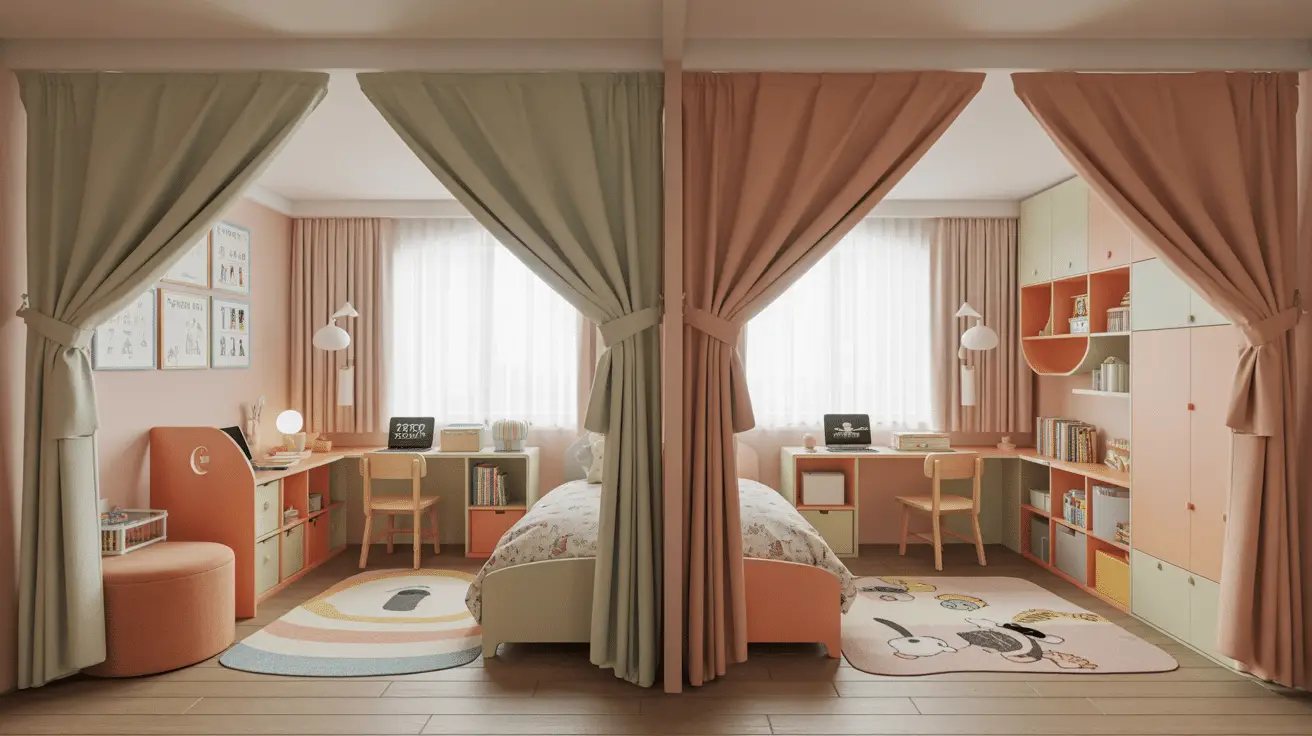Designing a Shared Colorful Kids Room for Siblings: Fun, Functional, and Harmonious Ideas
Table of Contents
Introduction
Designing a shared kids’ room for siblings presents a unique challenge: how to create a space that reflects each child’s personality while maintaining harmony in the overall design. Whether you have two kids with completely different tastes or siblings who share similar interests, the key is to find balance between individuality and cohesion.
The benefits of a well-designed shared kids’ room are numerous. It encourages collaboration and sharing, helps kids develop good habits around space organization, and fosters a sense of unity. However, making sure each sibling feels represented and comfortable in the same space is crucial. That’s where the fun (and creativity) of designing a shared, colorful room comes in.
In this blog post, we’ll explore various strategies for designing a shared kids’ room that is vibrant, fun, and functional. We’ll cover color selection, layout options, creative storage solutions, and ways to personalize the space to suit each child. Whether you have toddlers, teens, or something in between, this guide is packed with practical tips and real-world inspiration.
Choosing the Right Color Palette for a Shared Kids’ Room
When designing a colorful kids’ room, color is the first place to start. However, picking colors for siblings who may have different preferences can be a challenge. How do you choose colors that feel cohesive yet allow each child’s personality to shine?
Start by choosing a neutral base color for the walls and larger furniture pieces. Neutral shades like soft gray, off-white, or beige can provide a calming backdrop and allow bolder colors to pop. From there, use accents of each child’s favorite color—whether it’s a favorite toy, blanket, or bedding—as the primary source of color in the room.
For example, if one child loves blue and the other prefers pink, consider incorporating both hues in the room’s accessories (like rugs, throw pillows, or artwork), while keeping the furniture and walls neutral. This creates a room that feels balanced but still playful.
Key Tips for Color Selection:
- Use neutral tones for large surfaces to avoid overwhelming the space.
- Introduce bold accent colors through pillows, rugs, and artwork.
- Consider each child’s favorite color but maintain balance with harmonious combinations.
- Use patterns (e.g., stripes, polka dots) to incorporate multiple colors without creating chaos.
Creating Functional Zones in a Shared Room
A shared kids’ room requires an intuitive layout that allows each child to have their own space while still feeling connected. One effective approach is to create “zones” within the room. These zones can be based on activity, such as a sleeping area, study nook, and play zone, or can be more personalized, with each sibling having a dedicated corner for their individual needs.
The layout should consider both privacy and togetherness. For instance, you can use bookcases, curtains, or rugs to subtly separate the space while maintaining a feeling of openness. This allows siblings to enjoy their own space without feeling isolated from one another.
Tips for Zoning a Shared Room:
- Use room dividers or furniture like bookshelves to create distinct areas.
- Position the beds to allow for maximum space in the center of the room for playtime.
- Include multi-functional furniture, such as storage ottomans or bunk beds with built-in desks, to maximize space efficiency.
- Consider shared play items, like a large rug, to bring the room together while still allowing individual space.
Personalizing the Room for Each Sibling’s Style
While the room should have a cohesive overall design, it’s important to include personalized touches that make each sibling feel special. This can be achieved through their choice of bedding, wall art, or even furniture. If one child loves animals and the other prefers space exploration, create themed areas that reflect these interests, but tie them together through color and style.
You can add personal touches like framed drawings, monogrammed pillows, or customized storage bins that highlight each child’s interests. This personal flair makes the room feel like their own, even though it’s shared.
Ideas for Personalization:
- Customize their bedding with prints or characters they love.
- Use wall decals or wallpaper with designs that match their hobbies or interests.
- Create dedicated spaces for personal items, like a “reading nook” or a “craft station.”
- Let the kids choose a few decorative pieces to make the room truly their own.
Smart Storage Solutions for Siblings’ Shared Space
Storage is essential in a shared kids’ room, where keeping things organized can be a challenge. The trick is to choose storage solutions that are both functional and fun. Multi-functional furniture like beds with built-in drawers, under-bed storage, and floating shelves can help maximize space and keep things neat.
Use colorful bins or baskets for toys and art supplies, and encourage your kids to label them with pictures or words to help with organization. Additionally, consider adding a dedicated storage area for each sibling’s personal belongings to avoid clutter.
Storage Tips for Shared Rooms:
- Use stackable bins and baskets for easy-to-access storage.
- Incorporate multifunctional furniture like storage benches or desks with drawers.
- Create storage zones based on activities (e.g., one corner for toys, one for books).
- Keep clutter out of sight with hidden storage like built-in wardrobes or under-bed boxes.
Incorporating Playful and Fun Decor Elements
A colorful kids’ room wouldn’t be complete without playful decor that sparks imagination and creativity. Think of adding fun elements like a chalkboard wall for drawing, a reading tent for cozy corner play, or a wall mural that takes them to another world. These additions create a space where kids feel free to express themselves, and where they can enjoy hours of creative play.
When designing the decor, keep the overall theme in mind, but don’t shy away from whimsical elements. Whether it’s a whimsical lamp in the shape of an animal or a playfully patterned rug, these details make the room feel more inviting and fun.
Fun Decor Ideas to Add:
- Install a chalkboard wall for endless drawing possibilities.
- Add a tent or canopy for a fun and cozy reading nook.
- Hang fun, oversized wall art that adds a playful vibe.
- Incorporate playful patterns and textures in rugs, pillows, and curtains.
Maintaining Harmony Between Colorful Styles and Practicality
While a shared kids’ room should be fun, it also needs to be practical for everyday life. Consider elements that are easy to clean, durable, and functional. For instance, opt for washable fabrics for bedding and curtains, and use rugs that are stain-resistant.
In terms of furniture, choose pieces that are versatile and can grow with your kids. Bunk beds or convertible furniture can adapt as your children get older and their needs change. Balancing style with practicality ensures that the room remains both beautiful and functional in the long run.
Tips for Practical Yet Stylish Design:
- Use durable, easy-to-clean materials for bedding and upholstery.
- Choose long-lasting furniture that can grow with your children (e.g., bunk beds, convertible desks).
- Make sure the room is adaptable for various ages and stages.
- Incorporate light fixtures with dimmer switches to adjust ambiance.
Conclusion
Designing a shared, colorful kids’ room is all about balance—blending personality, practicality, and creativity. By focusing on thoughtful color choices, functional layouts, personalized details, and clever storage solutions, you can create a space that works for everyone. Ultimately, a well-designed kids’ room fosters a sense of unity, independence, and fun, making it a special place where siblings can grow, play, and learn together.
With these ideas in mind, you’ll be well on your way to creating a beautiful, colorful, and functional shared room that your kids will love.

